Air Operations, Europe - In Operation Bestrafung ('Punishment') the Luftwaffe attacks Belgrade and raids several Yugoslav air bases. German bombers and Stukas fly 500 sorties against the undefended Yugoslav capital. Many huge fires are started and many public buildings, hospitals and the Royal Palace are destroyed. Fleeing civilians are even strafed by the aircraft. The attacks are repeated over the next couple of days with Yugoslav dead numbering about 17,000.
- During the night there is an important air raid on the port of the Piraeus in which the British ammunition ship Clan Fraser blows up, sinking 13 other vessels and extensively damaging the port installations.
- An RAF Beaufort torpedo-bomber hits the Gneisenau at Brest. Wellington bombers hit Sofia, Bulgaria.
[  | |   ] ]
Atlantic - The German battlecruiser Gneisenau is badly hit by a British torpedo plane while on exercise just outside the port of Brest. On the night of April 10/11 the same ship is hit another 4 times by bombs during a British raid. The Scharnhorst is also in the port undergoing engine repairs. Neither battlecruiser will be able to join the Bismarck in its cruise in May.
- The British armed merchant cruiser Comorin (15,400t) is accidentally destroyed by fire en route to Freetown carrying military personnel and military stores for Suez with the loss of 14 on board. The British destroyer Lincoln rescues 121 survivors, the British steamer Glenartney 124 and the British destroyer Broke 180.
[  | |   ] ]
Balkans At 5:15a.m. German forces invade Yugoslavia and Greece in Operation Castigo. Italian and German newspapers announce: 'Axis forces are on the march against Serbian treachery and the British threat.' The attack begins with advances by List's 12th Army from Bulgaria and with bombing raids on Belgrade and targets in Greece. The initial forces from the 12th Army, will be joined over the next few days by von Kleist's 1st Pzr Group also part of 12th Army, Weich's 2nd Army and other German, Hungarian and Italian forces. Besides infantry forces the Germans employ 6 armored and 4 motorized divisions.
Yugoslav Unit Surrenders
|
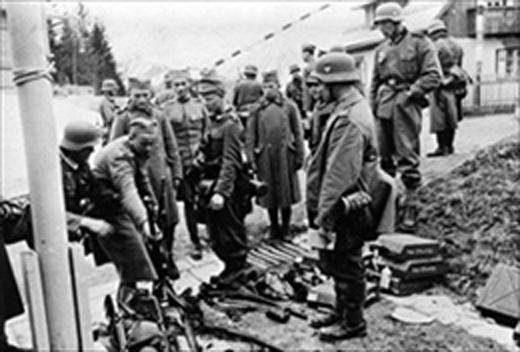 |
|
|
|
Yugoslav Royal Palace of King Peter II
|
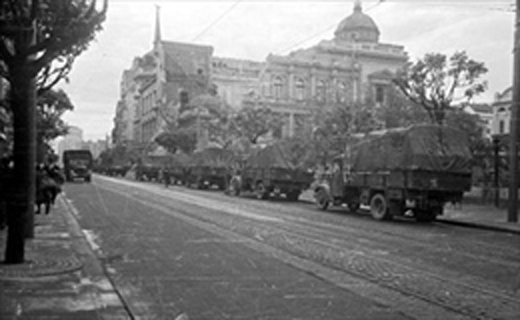 |
|
|
|
Street Damage in Belgrade
|
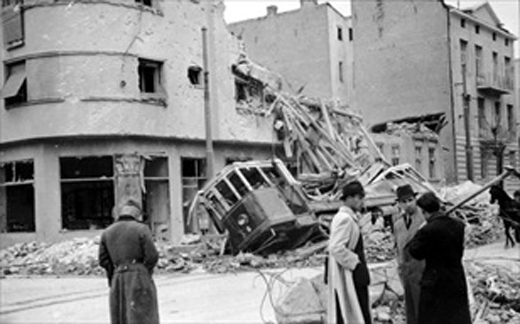 |
|
|
Nazi SS Troops Move into Greece
|
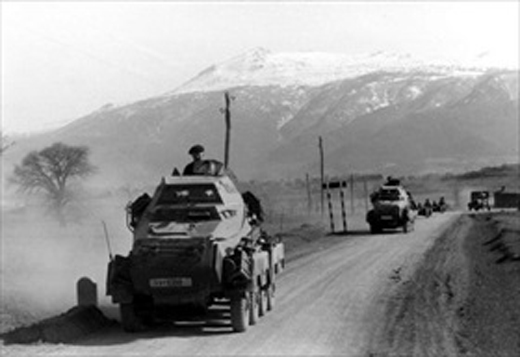 |
|
|
|
German Artillery in Action
|
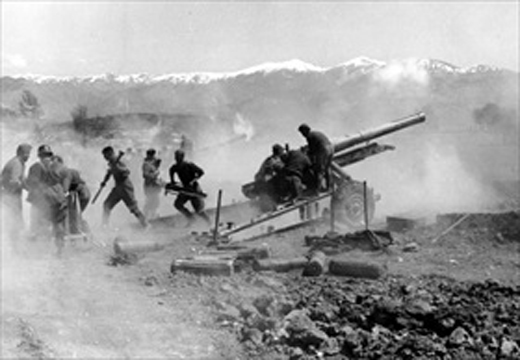 |
|
|
|
The Yugoslav Army has 28 infantry and 3 cavalry divisions but these are widely dispersed in a cordon defense of the frontier and only 5 infantry and 2 cavalry units will do any real fighting. The Germans also have overwhelming air support of around 1,000 planes from Fliegerkorps IV and VIII personally directed by Göring. Apart from the forces facing the Italians in Albania, in Greece the Allies have 7 weak Greek divs, the New Zealand Div, part of the 6th Australian Div and 1 British armored bde. There are about 80 RAF planes. Gen Wilson commands the British and Anzac forces which are based on positions known as the Aliakmon Line. There is a mixed tank and infantry force holding the route into Greece from Yugoslavia by the so-called Monastir Gap. Some of the Greek force are also on the Aliakmon Line but rather more are in frontier positions known as the Metaxas Line in Macedonia and Thrace.
Bomb Damage in Piraeus
|
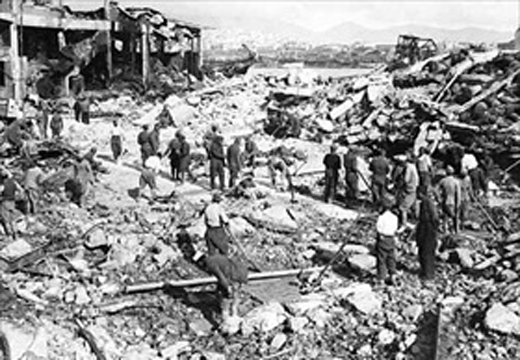 |
|
|
|
Bombing of Belgrade
|
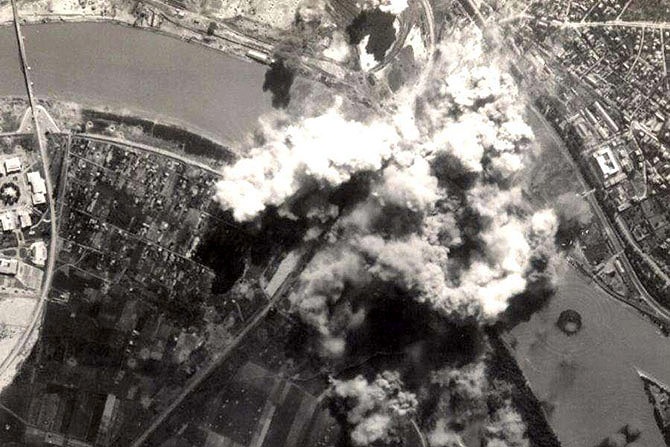 |
|
|
|
The main German attack on the first day falls on these advanced Greek troops. The German 2nd Army advances on Belgrade from Austria and Hungary. The I Pzr Group advances from Bulgaria towards Nis in the north and Skopje and Monastir in the south in order to keep Yugoslav troops from linking up with the Greeks. On this first day of hostilities the Germans seize the Yugoslav bank of the Iron Gate, the rocky gorge through which the Danube flows along the frontier between Rumania and Yugoslavia between Orsova and Turno-Severin. They also threaten Nis. The 12th Army attacks both in Yugoslavia towards Strumica and in Greeece against the Metaxas Line. The Yugoslav government flees from Belgrade to Uzice.
Germans Under Sniper Fire
|
 |
|
|
|
Stukas Over Yugoslavia
|
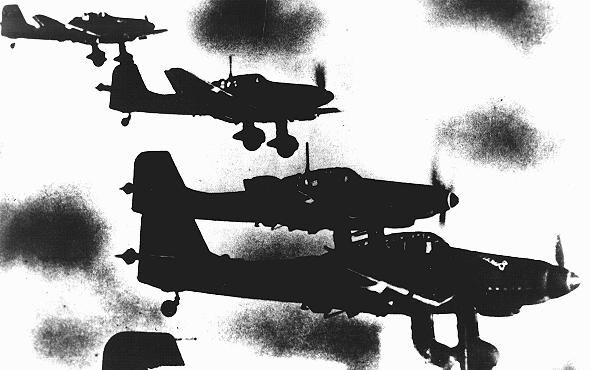 |
|
|
|
Italy declares war on Yugoslavia, and Italian troops occupy some frontier villages in Venezia Giulia.
[  | |   ] ]
Battle of the Atlantic - U-94 sinks the Norwegian tanker Lincoln Ellsworth (5580t) about 150 miles west of Iceland. Her entire crew of 29 is rescued 2 days later by the British armed merchant cruiser Derbyshire.
- German air attacks sink the British steamer Dunstan (5149t) northwest of Scotland with the loss of 2 crewmen. Survivors are picked up by the British destroyer Boadicea. The Greek steamer Nicolaou Zografia (7156t) is also sunk by an air attack west of Scotland. The entire crew of 31 is rescued by the British destroyer Eskimo. Also lost in an air attack is the British steamer Olga S. (2252t) northwest of Ireland. 4 of her crew are lost.
[  | |   ] ]
Diplmatic Relations The US Secretary of State, Cordell Hull, describes the German invasion of the Balkans as 'barbarous'.
[  | |   ] ]
Madagascar The Greek steamers Maroussio Logotheti (4669t) and Yiannis (4391t) are seized by Vichy French. The ships are renamed Duquesne and Amiral Pierra, respectively, for French use.
[  ] ]
Italian East Africa Addis Ababa, Abyssinia, is taken in the continuing Allied advance by the 12th African Div under command of Gen Edward Wetherall and also occupying the capital is the 1st South African Div. Since January 10, when Gen Cunningham's troops crossed the border into Italian Somaliland, until they entered Addis Ababa, the British have covered some 1,700 miles without ever having to fight a serious battle. Their total losses are only about 500 men while the Italians have lost the bulk of their arms, equipment and supplies and tens of thousands have been taken prisoner.
The Duke of Aosta is withdrawing to the north toward Amba Alagi with the remains of the main Italian force. Gen Luigi Frusci is in tactical command of these troops. Elsewhere in the country the Italians have about 80,000 more men. Gen Guglielmo Nasi commands in the Gondar area with half this force and Gen Pietro Gazzera in the south and southwest with the rest. The port of Massawa in Eritrea is attacked by the Allied forces with support from British naval vessels lying offshore.
[  | |   ] ]
North Africa The German and Italian advance is maintained. Axis troops occupy Mechili and Msus. On the coast the Australian 9th Div is beginning to pull back to Tobruk from Derna. Gen Richard O'Connor has now arrived at the front to advise Philip Neame but both are captured during the night by a German patrol. O'Connor, the architect of Beda Fomm, is an especially serious loss.
[  | |   ] ]
Red Sea More Italian steamers are scuttled: at Massawa, the Antonia C. (5877t) and the Riva Ligure (2136t). Scuttled off Dilac Island are the Nazario Sauro (8150t), the Tripolitania (2722t) and the Capitano Bottego (2316t).
[  | |   ] ]
|








